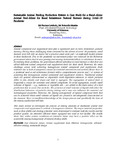| dc.description.abstract | Animal compound and supplement feed play a significant part in rural subsistence pastoral farming. During these challenging times presented by the advent of covid-19 pandemic, small farmers were left with no choice but to practice small-scale and / or makeshift feedlot systems in their backyards. Due to the pandemic no-movement policy was enforced by the Botswana government which lead to zero grazing and causing detrimental effects to subsistence farmers. In realising these problems, the government offered subsidises to rural farmers so that they can afford different animal compound and supplement feeds for their stock. However, the main challenge comes with achieving homogenous animal compound and supplement feeds mixtures due to lack of manpower caused by restricted movements and curfews. Hence there is a profound need to aid subsistence farmers with a comprehensive process and / or system of achieving this homogenous animal compound and supplement mixture. Traditional animal feeds are general characterised as dispersible multi-ingredient-mixtures in which particles differ in size, density and shape and tend to segregate. The segregation of animal feeds is frequently a reason for customer and official complaints. To avoid segregation, usually small volumes of liquids – e.g., molasses or vegetable oils – are added in the main mixer of a feed production line to cause fine particles. The presence of small volumes of liquids will affect the distribution behaviour of particles during mixing and it may also influence the material and technological properties. However, the mixing homogeneity of typical compound feeds that can be achieved when small volumes of liquids are present is not adequately characterised at the moment. There is insufficient knowledge of the design process and specifically the time of the mixing application will take.
This study strived to investigate the process of mixing amounts of traditional animal feed compounds and supplement to achieve a homogenous mixture. The major material properties, such as flow ability and dusting potential, were determined to evaluate both the results and the product quality. An intensive efficient mixer equipped was used as test facility. The results show that, under certain conditions an intensive mixer may have a positive effect on the achievable mixing homogeneity of mineral feeding stuffs. | en_US |

